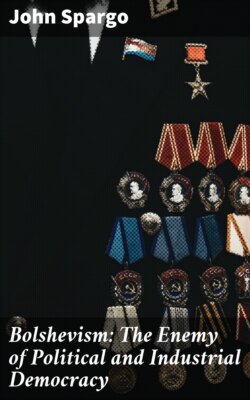Читать книгу Bolshevism: The Enemy of Political and Industrial Democracy - John Spargo - Страница 11
На сайте Литреса книга снята с продажи.
V
ОглавлениеThe result of all this was to drive the zemstvos toward the revolutionary movements of the peasants and the city workers. That the zemstvos were not naturally inclined to radicalism and revolution needs no demonstration. Economic interest, tradition, and environment all conspired to keep these popular bodies conservative. Landowners were always in the majority and in general the zemstvos reflected the ideas and ideals of the enlightened wealthy and cultivated classes. The peasant representatives in the zemstvos were generally peasants of the most successful and prosperous type, hating the revolutionists and all their works. By means of a policy incredibly insane these conservatively inclined elements of the population were goaded to revolt. The newspapers and magazines of the zemstvos became more and more critical of the government, more and more outspoken in denunciation of existing conditions. Presently, the leaders of the zemstvos followed the example of the revolutionists and held a secret convention at which a program for common action was agreed upon. Thus they were resorting to illegal methods, exactly as the Socialists had done. Finally, many of the liberal zemstvo leaders formed themselves into a political party—the Union of Liberation—with a special organ of its own, called Emancipation. This organ, edited by the brilliant and courageous Peter Struve, was published in Stuttgart, Germany, and, since its circulation in Russia was forbidden, it had to be smuggled into the country and secretly circulated, just as the revolutionary Socialist journals were. Thus another bond was established between two very different movements.
As was inevitable, revolutionary terrorism enormously increased. In the cities the working-men were drawn mainly into the Social Democratic Working-men's party, founded by Plechanov and others in 1898, but the peasants, in so far as they were aroused at all, rallied around the standard of the Socialist-Revolutionists, successors to the Will of the People party. This party was peculiarly a party of the peasants, just as the party of Plechanov was peculiarly a party of industrial workers. It emphasized the land question above all else. It naturally scorned the view, largely held by the Marxists in the other party, that Russia must wait until her industrial development was perfected before attempting to realize Socialism. It scorned the slow, legalistic methods and resolutely answered the terrorism of Czarism by a terrorism of the people. It maintained a special department for carrying on this grim work. Its Central Committee passed sentences of death upon certain officials, and its decrees were carried out by the members of its Fighting Organization. To this organization within the party belonged many of the ablest and most consecrated men and women in Russia.
A few illustrations will suffice to make clear the nature of this terroristic retaliation: In March, 1902, Sypiagin, the Minister of the Interior, was shot down as he entered his office by a member of the Fighting Organization, Stephen Balmashev, who was disguised as an officer. Sypiagin had been duly sentenced to death by the Central Committee. He had been responsible for upward of sixty thousand political arrests and for the suffering of many exiles. Balmashev went to his death with heroic fortitude. In May, 1903, Gregory Gershuni and two associates executed the reactionary Governor of Ufa. Early in June, 1904, Borikov, Governor-General of Finland, was assassinated by a revolutionist. A month later, July 15th, the infamous Von Plehve, who had been judged by the Central Committee and held responsible for the Kishinev pogrom, was killed by a bomb thrown under the wheels of his carriage by Sazanov, a member of the Fighting Force. The death of this cruel tyrant thrilled the world. In February, 1905, Ivan Kaliaiev executed the death sentence which had been passed upon the ruthless Governor-General of Moscow, the Grand-Duke Serghei Alexandrovich.
There was war in Russia—war between two systems of organized terrorism. Sometimes the Czar and his Ministers weakened and promised concessions, but always there was speedy reaction and, usually, an increased vigor of oppression. The assassination of Von Plehve, however, for the first time really weakened the government. Czarism was, in fact, already toppling. The new Minister of the Interior, Von Plehve's successor, Prince Svyatpolk-Mirski, sought to meet the situation by a policy of compromise. While he maintained Von Plehve's methods of suppressing the radical organizations and their press, and using provocative agents to entrap revolutionary leaders, he granted a certain degree of freedom to the moderate press and adopted a relatively liberal attitude toward the zemstvos. By this means he hoped to avert the impending revolution.
Taking advantage of the new conditions, the leaders of the zemstvos organized a national convention. This the government forbade, but it had lost much of its power and the leaders of the movement ignored the order and proceeded to hold the convention. At this convention, held at St. Petersburg, November 6, 1904, attended by many of the ablest lawyers, doctors, professors, scientists, and publicists in Russia, a resolution was adopted demanding that the government at once call representatives of the people together for the purpose of setting up a constitutional government in Russia. It was a revolutionary act, a challenge to the autocracy, which the latter dared not accept. On the contrary, in December the Czar issued an ambiguous ukase in which a number of concessions and reforms were promised, but carefully avoiding the fundamental issues at stake.
